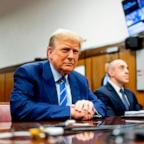Some Pay $100,000 for First A-380 Flight
Aboard the A-380: lobster, fine wines and maybe revolutionized travel.
ABOARD SINGAPORE AIRLINES FLIGHT 380, Oct. 25, 2007 — -- It took off almost two years late, but the first commercial flight of the Airbus A-380, the biggest passenger plane ever built, still made aviation history.
Before dawn, three hours before the scheduled departure for the flight from Singapore to Sydney, Australia, a long line of passengers waited at the check-in desk, filling Changi Airport with an excited buzz.
Passengers on the first scheduled flight operated by Singapore Airlines, the A-380 launch customer, bid for their seats in an Internet auction that raised $1.3 million for charity. Some paid as much as $100,000 for the first ride on the superjumbo in what was the biggest auction in eBay history.
Before cutting an appropriately giant ribbon to start the boarding process, Singapore Airlines chairman Chew Choo Seng said, "The A-380 sets the pace for a new generation of aircraft in the 21st century."
Boarding the double-decker — both the upper and lower decks are longer than the distance covered by the Wright Brothers first-powered flight — was quick and smooth, putting to rest industry analysts' warnings that the plane is so big that both getting on and off the plane would be problematic for passengers.
The giant aircraft taxied under a hazy morning sun to its takeoff point. The passengers, from more than a dozen countries around the world, dialed up friends and relatives on cell phones to give a play-by-play of the moments before takeoff and to describe the spacious interior. The passengers ranged in age from a 10-month-old boy traveling with his parents and three sisters to a 91-year-old grandmother.
Julian Hayward, 38, a wealthy Australian businessman with a passion for flight, bid $100,000 for the privilege of sitting in seat 1-A, one of a dozen luxurious private suites that make up the first-class section.
The suites have doors that close for privacy, reminiscent of a 19th century luxury train. The suites convert into real beds, and a full double bed can be created in side-by-side suites in the middle of the cabin, which is on the lower deck. All have a small sofa and 23-inch flat screen video monitors plus linens, pillows and dinnerware custom designed by Givenchy.
Lobster and Vintage Wines
Less than an hour into the flight, some of the 31 flight attendants began serving lunch, specially designed by chefs Matt Moran of Sydney and Sam Leong of Singapore. In first and business class it began with caviar washed down by 1996 Dom Perignon pink champagne.
Other courses followed, including smoked salmon, lobster, beef cheeks in a Japanese sauce, lamb, duck breast, international cheeses, dessert of coconut ice cream or frozen vanilla parfait, a half dozen vintage wines and your choice of tea, cappuccino or just plain old coffee. It was food that reflected modern in-flight cooking, which Moran said should end complaints from a previous generation that "all airplane food was awful."
A comparison was easy for Thomas Lee from Los Angeles, who sat in coach with his wife and daughter. Lee flew on the first commercial flight of the 747 on Jan. 21, 1970, from New York to London. That flight was not as smooth as today's flight of the big Airbus — an engine failed before takeoff that day almost 38 years ago, delaying the 747's maiden passenger flight.
"This is a different generation of planes," Lee said, "and this is a leap forward, and it's exciting and thrilling to be part of history."
The A-380 may have the promise to revolutionize airline economics just like the 747 did by carrying more passengers at a lower cost over a longer distance. Airbus designed the A-380 to fly between major hub cities from which passengers feed onto connecting flights to smaller towns.
That is directly opposite of rival Boeing's theory that the future of commercial aviation is embodied by its hot-selling 787, a smaller, but no less economically efficient plane designed to fly from places that are not major airline hubs.
The A-380 has been a slow seller, in part because the development program has been plagued with production delays. And it is unclear whether Airbus can sell the 250 more planes — at a list price of $300 million — needed to just recapture the $20 billion development costs.
But Singapore CEO Chew Choo Seng said the plane will be a winner. The delayed delivery schedule means that the A-380's U.S. debut will not take place for more than a year, when Singapore expects to begin service between Hong Kong and San Francisco.




